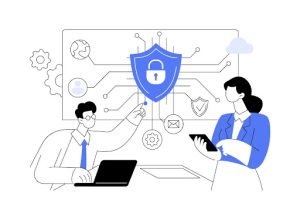
By Frontline Group
September 20, 2023

IT support call centers are essential for businesses, acting as the unseen force ensuring everything runs seamlessly. At its core, an IT support call center is a specialized hub where a dedicated team of experts stands ready to assist with technical issues, be they software glitches, hardware hiccups, or network nuances.
Functioning as the bridge between technology and its users, they employ a mix of advanced software tools, in-depth knowledge repositories, and, above all, a human touch. The end goal? To ensure seamless tech experiences for users, fostering a digital world where technology empowers rather than hinders.
They go beyond just resolving tech issues; they ensure everything from emails to crucial applications operates without a hitch. Their role in modern businesses is expansive, from troubleshooting to enhancing communication, securing data, and driving digital progress.
In this article, we’ll discuss the fundamentals of top-tier IT support, from core principles and team-building to process efficiency and data security.
Understanding the Basics of IT Support Call Centers
IT support call centers are technology’s lifeline, dedicated to assisting users with technical challenges. They efficiently resolve IT issues, from computer glitches to software malfunctions. Beyond troubleshooting, they educate on best practices, update systems, and proactively spot risks, ensuring a smooth digital experience for both employees and customers.
One of the fundamental roles of IT support teams is problem solving. These teams are adept at swiftly identifying technical problems, diagnosing their root causes, and putting effective solutions into action. It’s not just about fixing the problem; it’s about understanding its origins and ensuring it doesn’t reoccur.
Equally crucial is the provision of technical assistance. For many users, the world of IT is fraught with complex jargon and unfamiliar processes. That’s why IT support teams must be skilled at communicating clearly, patiently, and in a manner that’s user-friendly. They play a pivotal role in demystifying technology for users, guiding them through troubleshooting steps, and ensuring they’re comfortable with the solutions provided.
Beyond problem-solving and user assistance, the regular upkeep of systems is vital. System maintenance, which encompasses software updates, hardware upgrades, and system configurations, is a continuous responsibility. Such tasks are imperative for ensuring that systems operate without hitches and interruptions.
Moreover, the importance of documentation can’t be overstated. To provide efficient and consistent service, IT support teams maintain detailed records of common issues, the solutions employed, and best practices to follow. This documentation becomes a repository of knowledge, assisting both current and future team members in addressing technical challenges.
Training, too, plays an instrumental role. By offering guidance and training to end-users on the optimal and secure use of technology, IT support not only empowers users but also reduces the chance of recurrent issues. Knowledgeable users, after all, are less likely to inadvertently create tech problems.
Of course, despite all preventive measures, emergencies can arise. For such critical situations, having a robust disaster recovery plan is paramount. Preparedness ensures that when the unexpected happens, the downtime is minimized, and normal operations can resume as quickly as possible.
Lastly, the best IT support teams are not those that rest on their laurels. They are continuously driven by a spirit of improvement, always seeking ways to refine their support processes and workflows, ensuring that they offer the best possible service to their users.
Types of IT support calls and issues
- Hardware Issues: Problems with computers, servers, printers, or other physical devices, such as hardware failures, connectivity issues, or component replacements.
- Software Troubles: Issues related to software applications, including installation problems, crashes, bugs, and compatibility issues.
- Network and Connectivity: Problems with internet connections, Wi-Fi, VPNs, or network configurations affecting users’ ability to access resources or work remotely.
- Security Concerns: Handling security incidents, such as malware infections, data breaches, or unauthorized access attempts.
- User Account and Access: Managing user accounts, passwords, and access permissions, including resetting passwords, granting access, and revoking privileges.
- Data Loss and Recovery: Dealing with data loss scenarios, accidental deletions, and data recovery efforts.
- User Training and Guidance: Providing guidance to users on how to use software and tools effectively and promoting cybersecurity awareness.
Understanding these various types of support calls and issues is crucial for IT support teams to efficiently allocate resources and deliver prompt solutions tailored to each situation. By doing so, they ensure that businesses continue to operate smoothly and users are able to make the most of the technology at their disposal.
Building a Strong IT Support Team
Building a top-notch IT support team starts with selecting the right individuals who can handle the dynamic challenges of the tech world. For an outstanding IT support team, begin with a solid foundation of technical proficiency, ensuring they can effectively address issues.
Equally vital is their ability to communicate complex details simply, especially to those less familiar with tech. Prioritize problem-solving skills, as challenges are frequent in IT; having team members who can calmly address these is essential.
Despite their expertise, continuous training is crucial to keep pace with the ever-evolving tech landscape. Don’t overlook soft skills like empathy and active listening, which enhance user trust and experience. Encourage obtaining IT certifications, validating and boosting skills.
Finally, promote a learning culture, especially through mentorship, to ensure the team’s consistent growth and adaptability.
A supportive work environment is the breeding ground for a high-performing IT support team. Here are some ways to foster such an atmosphere:
- Collaboration: Promote teamwork for collective problem-solving. Regular meetings help share knowledge.
- Recognition: Reward and acknowledge standout performance for higher morale and motivation.
- Flexibility: Offer work flexibility to support a work-life balance, leading to content and efficient employees.
- Clear Goals: Define performance expectations for clarity in roles and purpose.
- Feedback: Maintain open feedback channels, ensuring team members feel valued and heard.
A solid and cohesive team is the cornerstone of providing superior IT support services to your organization.
Implementing Efficient IT Support Processes
To provide top-notch service, it’s crucial to have efficient IT support processes in place that streamline issue resolution and keep your users happy.
Effective incident management is vital, ensuring that every IT request is addressed meticulously and without oversights. This is streamlined using ticketing systems which help in organizing and tracking requests. These systems provide clarity, featuring tools like task assignments and histories of interactions.
It is equally important to be able to prioritize, ensuring that critical issues, assessed by business impact and affected users, are addressed promptly. By categorizing issues into groups like hardware or software, one can identify trends and pinpoint areas where proactive measures are needed.
Proper escalation is key — complex issues should be routed effectively, starting from front-line support to specialized technicians or even third-party vendors when necessary. It’s essential to have a timely escalation process in place with clear criteria, ensuring challenging issues are addressed swiftly. By setting up Service Level Agreements (SLAs), expectations regarding response and resolution times are clearly defined, ensuring accountability.
Lastly, with varied response goals for different challenges, the focus remains on prioritizing user satisfaction and needs.
Utilizing Technology for Better Service
In the ever-evolving landscape of IT support, technology is a driving force behind delivering excellent service. Let’s explore how various technological advancements enhance your IT support services:
- Streamlined Workflows: Automation handles routine tasks like software updates and password resets, allowing teams to tackle intricate issues.
- Quick Resolutions: Automated workflows offer rapid solutions, enhancing user satisfaction.
- Proactive Monitoring: Automation detects system anomalies, prompting timely intervention before users are affected.
- Remote Troubleshooting: IT teams can resolve issues from afar with remote tools, minimizing user disruptions.
- AI Triage: Chatbots streamline support by gathering user details and recommending solutions.
- 24/7 Support: Chatbots offer consistent assistance, which is vital for global businesses.
Incorporating these technological advancements into your IT support strategy enhances service quality and optimizes efficiency and user satisfaction. These powerful tools enable IT support teams to deliver faster, more accessible, and more consistent assistance to users, ultimately contributing to a positive support experience.
Effective Communication with Users
For a successful IT support team, communication skills are paramount. Begin by actively listening to users. By fully focusing on them and asking clarifying questions, not only is an accurate diagnosis more attainable, but users also feel genuinely valued. It’s equally vital to empathize with users, understanding their feelings and frustrations, which signals a real concern for their experience.
Clarity in communication is a must, and this involves simplifying technical explanations, using visuals where possible, and steering clear of jargon. Solutions should be concise and straightforward, without unnecessary details, ensuring users can easily follow along. After providing instructions, it’s essential to confirm that users grasp them and are open to any further queries they might have.
Maintaining transparency about resolution timelines is crucial, as is regularly updating users on the progress. Aim to exceed their expectations by delivering solutions faster than promised. When faced with stressed callers, patience is key; a calm approach helps diffuse tensions.
While empathy is important, it should be paired with active problem-solving, offering concrete solutions. And, if an issue proves too intricate, escalating it to specialized teams is essential, giving users the confidence that their concerns are taken seriously.
Measuring and Improving Service Quality
Continually improving and optimizing your service elevates your entire IT support system. It’s essential to begin by measuring the quality of your IT support services using some of the following data points and key performance indicators (KPIs) for IT support.
- Incident Resolution Time: Measures efficiency in solving issues, with quicker times indicating quality service.
- First Call Resolution: High rates show expertise, resolving issues in one interaction, enhancing user experience.
- CSAT Score: Directly gauges user satisfaction with support.
- Response Time: A rapid response enhances user experience.
- Ticket Volume: A tool to assess workload and detect potential underlying problems.
- User Feedback: Use open-ended queries to gain insights into areas of enhancement.
- Benchmarking: Compare performance with industry standards to spot excellence and improvement areas.
Measuring and improving service quality is an ongoing commitment to excellence. By monitoring performance, your IT support team can consistently provide top-notch service that meets user expectations and evolves with the changing technological landscape. Remember, pursuing excellence is a journey, not a destinati
Ensuring Security and Data Privacy
In the realm of IT support, safeguarding sensitive data and maintaining robust security practices are paramount. Let’s explore some of the best practices for data security in IT support.
- Access Control: Grant access to sensitive data only to authorized personnel.
- Data Encryption: Shield data, both in transit and at rest.
- Software Updates: Maintain up-to-date systems to ward off vulnerabilities.
- Password Policies: Enforce robust passwords and consider multi-factor authentication.
- Network Monitoring: Utilize firewalls and intrusion detection.
- Data Classification: Categorize data based on sensitivity.
- Compliance Adherence: Meet standards like GDPR or HIPAA.
- Secure Storage: Implement encryption, access limits, and audits.
- Data Retention: Set storage periods and safe disposal methods. I
- Phishing Drills: Run simulated phishing tests. Report Mechanisms: Encourage immediate reporting of security concerns.
By implementing best practices for data security, ensuring compliance with relevant regulations, and fostering a culture of cybersecurity awareness through training and education, your IT support team can fortify its defenses against potential threats.
Protecting sensitive information and data privacy is not just a responsibility; it’s a commitment to maintaining trust and integrity in your IT support services.
Superior IT Support With Frontline Group
Partnering with Frontline Group ensures you’re backed by industry-leading expertise tailored to reflect your brand’s unique identity. Their comprehensive understanding of diverse sectors, combined with an emphasis on personalized service, ensures your brand’s essence shines through every interaction.
With state-of-the-art technology, AI integrations, and stringent security measures, Frontline Group guarantees efficient, safe, and personalized customer interactions every time.
So, if you’re searching for ways to elevate your call center operations and offer unmatched customer experiences, look no further. Frontline Group is not just a service provider — they’re a partner in your journey to excellence.
Ready for a seamless transition to superior customer satisfaction? Reach out for a customized quote by emailing cx@frontlinegroup.azurewebsites.net or filling out our user-friendly online form.





